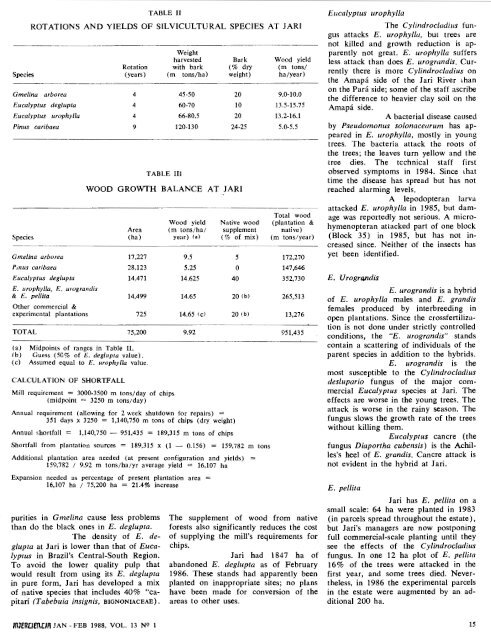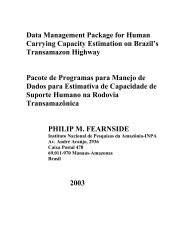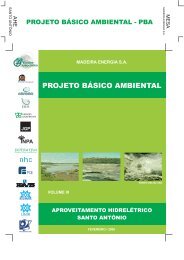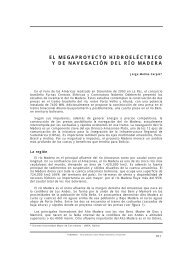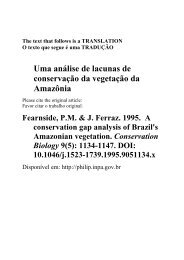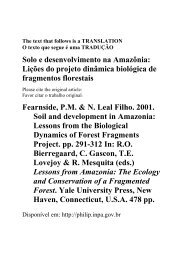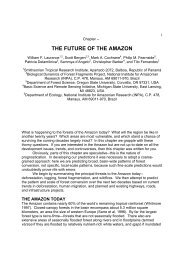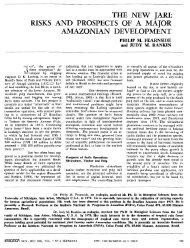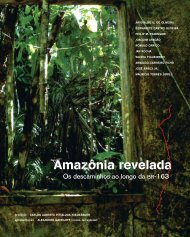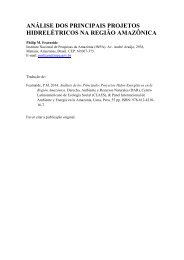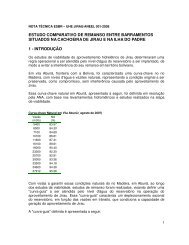TABLE IIROTATIONS AND YIELDS OF SILVICULTURAL SPECIES AT JARIWeightharvested BarkRot<strong>at</strong>ion with bark (% drySpecies (years) (m tons/ha) weight)Gmelina arborea 4 45-50 20Eucalyptus deglupta 4 60-70 10Eucalyptus urophy/la 4 66-80.5 20Pinus caribaea 9 120-130 24-25TABLE IllWOOD GROWTH BALANCE AT JARIWood yieldArea (m tonslhalSpecies (ha) year) (a)Gmelina arborea 17,227 9.5Pinus caribaea 28,123 5.25Eucalyptus deglupta 14,471 14.625E. urophylla, E. urograndis& E. pel/ita 14.499 14.65Other commercial &experimental plant<strong>at</strong>ions 725 14.65 (c)TOTAL 75,200 9.92(a)I b)(c)Midpoints of ranges in Table II.Guess (50% of E. deglupta value).Assumed equal to E. urophy/la value.CALCULATION OF SHORTFALLMill requirement = 3000-3500 m tons/day of chips(midpoint = 3250 m tonslday)Annual requirement (allowing for 2 week shutdown for repairs)351 days x 3250 = 1,140,750 m tons of chips (dry weight)Annual shortfall = 1,140,750 - 951,435 = 189,315 m tons of chipsN<strong>at</strong>ive woodsupplement(% of mix)504020 (b)20 (b)Shortfall from plant<strong>at</strong>ion sources = 189,315 x (1 - 0.156) = 159,782 m tonsAdditional plant<strong>at</strong>ion area needed (<strong>at</strong> present configur<strong>at</strong>ion and yields)159,782 1 9.92 m tonslhalyr aver<strong>age</strong> yield = 16,107 haExpansion needed as percent<strong>age</strong> of present plant<strong>at</strong>ion area =16,107 ha 1 75,200 ha = 21.4% increasepurities in Gmelina cause less problemsthan do the black ones in E. deglupta.The density of E. deglupta<strong>at</strong> Jari is lower than th<strong>at</strong> of Eucalyptusin Brazil's Central-South Region.To avoid the lower quality pulp th<strong>at</strong>would result from using its E. degluptain pure form, J ari has developed a mixof n<strong>at</strong>ive species th<strong>at</strong> includes 40% "capitarf(Tabebuia insignis, BIGNONIACEAE).Wood yield(m tons/hajyear)9.0-10.013.5-15.7513.2-16.15.0-5.5Total wood(plant<strong>at</strong>ion &n<strong>at</strong>ive)(m tons/year)172,270147,646352,730265,51313,276951,435The supplement of wood from n<strong>at</strong>iveforests also significantly reduces the costof supplying the mill's requirements forchips.Jari had 1847 ha ofabandoned E. deglupta as of February<strong>19</strong>86. These stands had apparently beenplanted on inappropri<strong>at</strong>e sites; no planshave been made for conversion of theareas to other uses.Eucalyptus urophyllaThe Cylindrocladius fungus<strong>at</strong>tacks E. urophylla, but trees arenot killed and growth reduction is apparentlynot gre<strong>at</strong>. E. urophylla suffersless <strong>at</strong>tack than does E. urograndis. Currentlythere is more Cylindrocladius onthe Amapii side of the Jari River thanon the Para side; some of the staff ascribethe difference to heavier clay soil on theAmapii side.A bacterial disease causedby Pseudomonus solonacearum has appearedin E. urophylla, mostly in youngtrees. The bacteria <strong>at</strong>tack the roots ofthe trees; the leaves turn yellow and thetree dies. The technical staff firstobserved symptoms in <strong>19</strong>84. Since th<strong>at</strong>time the disease has spread but has notreached alarming levels.A lepodopteran larva<strong>at</strong>tacked E. urophylla in <strong>19</strong>85, but dam<strong>age</strong>was reportedly not serious. A microhymenopteran<strong>at</strong>tacked part of one block(Block 35) in <strong>19</strong>85, but has not increasedsince. Neither of the insects hasyet been identified.E. UrograndisE. urograndis is a hybridof E. urophylla males and E. grandisfemales produced by interbreeding inopen plant<strong>at</strong>ions. Since the crossfertiliz<strong>at</strong>ionis not done under strictly controlledconditions, the "E. urograndis" standscontain a sc<strong>at</strong>tering of individuals of theparent species in addition to the hybrids.E. urograndis is themost susceptible to the Cylindrocladiusdeslupario fungus of the major commercialEucalyptus species <strong>at</strong> Jari. Theeffects are worse in the young trees. The<strong>at</strong>tack is worse in the rainy season. Thefungus slows the growth r<strong>at</strong>e of the treeswithout killing them.Eucalyptus cancre (thefungus Diaportha cubensis) is the Achilles'sheel of E. grandis. Cancre <strong>at</strong>tack isnot evident in the hybrid <strong>at</strong> Jari.E. pellitaJari has E. pellita on asmall scale: 64 ha were planted in <strong>19</strong>83(in parcels spread throughout the est<strong>at</strong>e) ,but Jari's man<strong>age</strong>rs are now postponingfull commercial-scale planting until theysee the effects of the Cylindrocladiusfungus. In one 12 ha plot of E. pellita16% of the trees were <strong>at</strong>tacked in thefirst year, and some trees died. Nevertheless,in <strong>19</strong>86 the experimental parcelsin the est<strong>at</strong>e were augmented by an additional200 ha.ll\7fR[/ffi[lfl JAN- FEB <strong>19</strong>88, VOL. 13 N9 115
B) Experimental Plant<strong>at</strong>ion SpeciesJari's ability to we<strong>at</strong>herfuture biological problems will be largelydetermined by the availability of altern<strong>at</strong>ivesilvicultural species. Adequ<strong>at</strong>etesting of potential species, carried out<strong>at</strong> the site, is the best means of minimizingthe risk of an inappropri<strong>at</strong>e choice.The following species are under testing:E. grandis: Jari installeda 14 ha experimental planting of E.,grandis from a loc<strong>at</strong>ion in Australiabelieved to be similar to J ari. Trees fromthis procedence are thought to offer agood chance of resisting the cancre th<strong>at</strong>often <strong>at</strong>tacks plant<strong>at</strong>ions of this species.Finding altern<strong>at</strong>ive Eucalyptus species isa sufficiently high priority <strong>at</strong> J ari th<strong>at</strong>14 ha of one-year-old commercial pineplant<strong>at</strong>ion were sacrificed to install theexperiment in <strong>19</strong>85.E. camaldulensis: Althoughthis species is sometimes used forpulp (United St<strong>at</strong>es, NAS <strong>19</strong>80: 126) theonly potential use for it <strong>at</strong> Jari would befor firewood. Despite enthusiasm amongthe research staff under Ludwig and goodgrowth in experimental plant<strong>at</strong>ions(<strong>Fearnside</strong> and Rankin, <strong>19</strong>82), thespecies is no longer under consider<strong>at</strong>ionfor commercial plant<strong>at</strong>ion due to poorpulping characteristics.E. tornelliana: This speciesgrows well <strong>at</strong> Jari, quickly shadingout the undergrowth. However, it is nota good pulping species and only can beused for firewood.E. brassiana: Growthsince testing began in <strong>19</strong>84 has not beengood.E. pillularis: A test plotof this species planted in <strong>19</strong>85 is tooyoung to be evalu<strong>at</strong>ed.Pinus oocarpa: Thisspecies has poorer growth than P. caribaeain the first two years but thenc<strong>at</strong>ches up and grows faster. P. oocarpamust be maintained with more thoroughweeding than P. caribaea until it reachesa height of two meters (in approxim<strong>at</strong>elytwo years). P. caribaea can surviveeven if left in a heavily weed-infestedstand with only the tips of the treesshowing. P. oocarpa often starts itsgrowth lying down or in other ways th<strong>at</strong>produce poor form. It also has morebranches and side sprouts near theground. The staff consider P. oocarpa tobe more susceptible to the Cylindrocladiusfungus than is P. caribaea. It alsohas high variability in the growth amongindividual trees - not a good characteristicfor plant<strong>at</strong>ions, but one th<strong>at</strong> allowsrapid genetic selection. P. oocarpa basSourceTABLE IVSUPPLEMENTARY WOOD SOURCES AT JARI (<strong>19</strong>85/86)Deforest<strong>at</strong>ion for plant<strong>at</strong>ionsEMBRAPA experimentsCapitari (Tabebuia insignis)Purchase of Pinus caribaea chipsTOTAL (103 m tons)PERCENT OF TOTAL PULPWOODNote(a)(b)(c)(d)(e)Aproxim<strong>at</strong>eweight (103m tons/year)26.250.548478188.79(a) Approxim<strong>at</strong>ely 3000 ha felled for plant<strong>at</strong>ions in <strong>19</strong>85. Aver<strong>age</strong> wet weight biomass oflogs = 350m tons;ha (Feamside and Rankin, <strong>19</strong>85: 125), or approxim<strong>at</strong>ely 175 m tons/hadry weight. The dry weight pulped per hectare felled is approxim<strong>at</strong>ely 8.75 m tons, since5% of the species arc used for pulp; these species are assumed to represent the samepercent<strong>age</strong> of harvested biomass. This is consistent with the 10% of biomass used forpulping in <strong>19</strong>83 (<strong>Fearnside</strong> and Rankin, <strong>19</strong>85: 125) when twice the present number of specieswere used for pulpin~:.(b) total amount harvested = 18 x 103 m3; aver<strong>age</strong> density = 0.6; assume 5% used as innote (a).(c) 4 month Eucalyptus run ( = 120 days) x 700 ~ tons capitari/day.(d) 390 x 103 m tons chip demand (From Table V) x 20% supplied from purchases (<strong>19</strong>85;86value).(e) 1,140,750 m tons for oper<strong>at</strong>ion <strong>at</strong> full capacity (see Table III).the advant<strong>age</strong> of very little foxtailing ascompared to P. caribaea. The species isconsidered a potential option for commercialplanting should a change be desirable,but J ari has no immedi<strong>at</strong>e plansfor such a change.Anthocephalus chinensis:This species, which had been growingwell in an experimental stand on fairlygood soils (<strong>Fearnside</strong> and Rankin, <strong>19</strong>80),died mysteriously in <strong>19</strong>84 <strong>at</strong> an <strong>age</strong> ofapproxim<strong>at</strong>ely six years. No diseasesymptoms, insect <strong>at</strong>tack, or other problemswere evident.Casuarina: Testing ofthis Asian legume was enthusiasticallyiniti<strong>at</strong>ed under the previous man<strong>age</strong>mentin about <strong>19</strong>79. The species is only usabfefor firewood. Experiments are not continuing."Para-Para" (Jacarandacopaia): This n<strong>at</strong>ive species has goodgrowth but requires rel<strong>at</strong>ively fertilesoil. Many but not all trees are <strong>at</strong>tackedby Hysipyla shootborers (pit mothlarvae) (<strong>Fearnside</strong> and Rankin, <strong>19</strong>80).Small-scale experiments continue."Mungubeira" ( Bombaxmunguba): Experiments th<strong>at</strong> were initi<strong>at</strong>edshortly before the end of Ludwig'stenure have not been pursued. Mungubeirais a n<strong>at</strong>ive of the Amaz:Onianvtirzea and grows well there.17%"Taxi Preto" (Triplarisfilipensis): A 1 ha plot of this n<strong>at</strong>ivespecies was planted in <strong>19</strong>85. The youngtrees suffered some dam<strong>age</strong> by grasshoppersand ants.To summarize the st<strong>at</strong>usof the search for new species, both exoticand n<strong>at</strong>ive, Jari has a number of speciesunder testing, a few of which have givenreasonably positive results <strong>at</strong> the site. Nospecies is currently <strong>at</strong>tractive enough tosuggest any likely changes in the choicesfor commercial plant<strong>at</strong>ions over the nextfew years, but some are sufficiently welladapted th<strong>at</strong> they could be called uponshould biological problems arise th<strong>at</strong> arehighly damaging to Pinus caribaea or thecurrent Eucalyptus species. No such safeguardexists in the case of J ari's hallmarkspecies: Gmelina arborea. No n<strong>at</strong>ivespecies are under serious consider<strong>at</strong>ionfor commercial planting.C) Silvicultural Man<strong>age</strong>mentOne casualty of the costcuttingmeasures during Jari's financialsqueeze has been the recycling of some ofthe pulp mill's residuals to the plant<strong>at</strong>ions.In the long term the outflow ofnutrients through biomass harvesting,soil erosion and other p<strong>at</strong>hways must be16JAN- FEB <strong>19</strong>88, VOL. 13 NQ 1 ll\7fR(Ifl\(ltl


